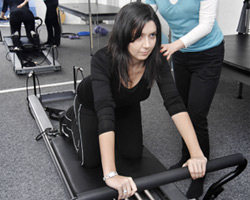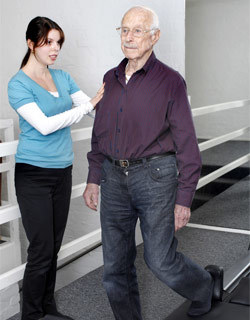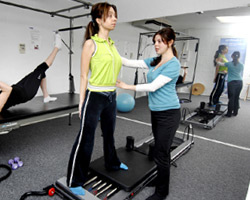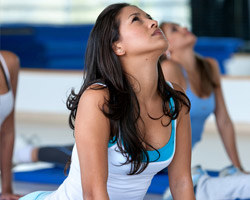Conditions Treated
Our range of physiotherapy approaches has been proven extremely effective in disease prevention and treatment.
Do you suffer from any of the following? Our physiotherapists have extensive experience in helping patients successfully treat these issues. Results often felt after just 1-3 sessions.

Back, Neck and Joint Pain
While the causes for back, neck and joint pain vary greatly the treatment generally follows the same rules – reduce your symptoms and then prevent recurrences by strengthening your “core muscles”.
Following a thorough assessment during which we correctly diagnose the cause of your pain we will recommend the most beneficial treatment for you.
We will work together with you to reduce your pain and help you to prevent future flare ups.
Common methods include SCENAR therapy, electrotherapy, manual therapy, Clinical Pilates and hydrotherapy.

Headaches
A headache is defined as pain in any region of the head; in the forehead, behind the eyes, above the ears or at the base of the skull.
One of the most common types of headaches are those originating from your neck (cervicogenic headaches). Over the years we have helped many patients manage and often virtually abolish their headaches.
The first step is to correctly identify the cause of your headache. Once this is established we are able to select the most beneficial treatment for you.
SCENAR therapy, electrotherapy and manual therapy will reduce your symptoms, also helping to treat the cause. Once your headaches are under control we strive to prevent future recurrences by improving your posture and strengthening the muscles which stabilize and support your neck and back.

Osteo & Rheumatoid Arthritis
Arthritis is an umbrella term for many types of arthritis which have a number of different causes.
If you have arthritis you know how debilitating it can be. Arthritis can affect any joint in the body. It causes joint deformities which can be painful, cause inflammation, swelling and stiffness. This can affect the ligaments and muscles around the joint as well. As a result of this deformity and pain, the joints become weaker and mobility becomes abnormal, which can further increase pain.
At Health Point Physiotherapy, we offer specialised treatments to reduce the pain and inflammation you experience from arthritis. Common methods include SCENAR therapy, electrotherapy and drug phoresis.
Once your pain and inflammation are under control we move towards a strengthening and mobility program to help you manage your arthritis in the long run. Clinical Pilates and hydrotherapy are extremely effective for this.

Scoliosis
Scoliosis is when the spine curves sideways and the vertebrae are rotated.
It can have various physiological effects depending on the severity of the curves, as well as cosmetic effects.
There are different types of scoliosis, some are idiopathic (the cause is not known) and while some have identifiable causes.
Common types of idiopathic scoliosis are as follows:
• Infantile idiopathic scoliosis – develops when the child is younger than two years old.
• Juvenile idiopathic scoliosis – develops between ages 2-10 years.
• Adolescent idiopathic scoliosis – develops during adolescence. This presentation is much more common in girls than boys.
Adolescent scoliosis is the most common scoliosis seen. There is usually a family history of scoliosis but there are no definite rules about inheritance of scoliosis yet.
The curve tends to develops the most during the adolescent growth spurts, this being around 11-13 years of age for girls, and 13-15 years for boys.
Physiotherapy can assist with management of scoliosis in the following ways:
• helping to reduce pain and stiffness
• improve the posture and core strength which leads to a stronger spine
• improving the cosmetic appearance
One of the most effective management options for scoliosis is PSSE (Physiotherapy Specific Scoliosis Exercises).
Another very useful tool is Real Time Ultrasound which we routinely use at Health Point Physiotherapy. This helps to ensure correct activation of the core muscles.
Read more about how physiotherapy can help scoliosis on our Health Care for Children page. Also see our blog to read the following articles:

Sports Injuries
Sport is a huge part of Aussie life. So when enjoying the sports we play it is important to look after our bodies to reduce the risk of injury.
If you love sport you’ll try hard to avoid injuries but you will also appreciate the importance of a swift recovery if an injury does occur.
One of the most common reasons for sports injuries is incorrect technique which puts strain on your spine, joints and muscles. Our physiotherapists, who all have a sporting background, can help with this by identifying any biomechanical issues which arise from your sport and helping you fix these. Correcting these issues can help you play the sport you love without pain, reduce risk of injury and improve your sport performance.
Even if you have no injuries, Clinical Pilates is a great compliment to any sport. It helps strengthen the core muscles which stabilise your spine and joints as well as all other muscles. This will improve your sporting technique and reduce the risk of injury. We design programs for the casual sports player or for someone who wants to get more of an edge in their competitive sports performance.
Common sport injuries/pains:
• Muscle strains or tears
• Tendinopathies
• Joint sprains or dislocations
• Patellar-femoral (knee) joint pain
• Shoulder impingement syndrome
• Back or neck pain
• Sacro-iliac joint pain (low back/pelvis)
See our articles and blog posts on the following topics:
How to Prevent Sports Related Injuries
Sports Injuries - The Elbow (published in the Great Health Guide magazine)
Achilles Tendinopathy (published in the Great Health Guide magazine)
Plantar Fasciitis (published in the Great Health Guide magazine)
Knee Pain (published in the Great Health Guide magazine)
Hamstring Strains (published in the Great Health Guide magazine)
Preventative Health for Muscles (published in the Great Health Guide magazine)
How to Prevent Injuries When Starting a New Sporting Activity
Tennis/Golfers Elbow (Lateral/Medial Epicondylitis)
Tennis elbow and golfers elbow, more correctly known as lateral and medial epicondylitis (respectively), are two of the most common causes of elbow pain.
These injuries can occur as a result of a number of sports, such as tennis, swimming, weightlifting and others, as well as due to repetitive tasks involved in various types of occupations, most commonly computer work.
Common symptoms include pain, lack of strength and/or flexibility in the elbow and wrist as well as poor sporting technique. These will usually manifest primarily when performing tasks involving gripping.
In most cases tennis elbow, as well as golfers elbow, respond very well to physiotherapy treatment. Results are generally seen after just 1-3 sessions. The initial treatment often involves the use of electrotherapy modalities and SCENAR therapy. Once the pain is under control the focus shifts towards a specific strengthening and flexibility program using specialized exercises, Clinical Pilates and other approaches.
See our article Sports Injuries - The Elbow (published in the Great Health Guide magazine)

Women's Health Problems
At Health Point Physiotherapy our physiotherapists have undergone specific training in the field of women’s health. Where appropriate, we use Real Time Ultrasound to assess the strength and functionality of your core stabilizers and pelvic floor muscles.
All of our therapeutic programs are therefore specifically tailored to the needs of women of various ages and health conditions. Our broad spectrum of treatment techniques will enable us to choose the modality which will be of most benefit to you.
Physiotherapy is widely used in the treatment of different gynaecological pathologies. It is highly effective in managing dysmenorrhoea, pelvic inflammatory disease, female sexual dysfunction, chronic pelvic pain, reproductive problems and other conditions.
For younger women, areas of special relevance may be preparation for getting pregnant and subsequently a comfortable pregnancy, easy labour and successful post-birth recovery including treatment for mastitis. Our Expectant and New Mothers health program will greatly assist you in this regard.
As women get older, the risk of developing osteoporosis can increase. In order to prevent this or stop it from progressing it is extremely important to maintain a specific, healthy diet as well as get plenty of weight bearing exercise (exercise done on land rather than in water). Adequate and safe sun exposure is another vital area. You will be able to get most of the recommendations following your full body assessment or during the initial treatment session.
In some cases, if you suffer from a specific gynaecological condition Clinical Pilates will not be the best treatment approach and electrotherapy, drug phoresis, SCENAR therapy or balneotherapy will be more indicated. Please do not hesitate to contact us for more information.

Incontinence
Incontinence is another area of serious concern for women as well as men. At Health Point Physiotherapy we have a number of clinically proven and highly effective treatment options. We help patients of various age groups, both men and women, suffering from stress and urge urinary incontinence as well as fecal incontinence.
The first step is always to correctly diagnose the cause of the incontinence. Next we look at contributing factors such as the physical activity that the patient is doing, diet, obesity, urinary tract infections, constipation and others. We then prepare a specific treatment program for each patient.
Pelvic floor exercises are always the long term solution and has been proven by research to be the first line treatment for incontinence. See our article Pelvic Floor Exercises for Stress and Urge Incontinence. Where exercises alone are not enough we use certain electrotherapy treatments to speed up the progress. See our article Electrotherapy for Treatment of Urinary Incontinence for more information.
Pelvic floor exercises can be incorporated into your Clinical Pilates program or be in the form of a home exercise program with regular monitoring.
Real Time Ultrasound is used to assess both the core and the pelvic floor muscles, which means that you can be confident that you are activating the muscles correctly since you will see the action on the screen. Without the use of Real Time Ultrasound it is easy to bear down instead of performing a pelvic floor lift which will exacerbate incontinence.
More information can be found on our Incontinence and Women's Health Program page. Also see our blog to read the following articles:
Prevention and Management of Incontinence (published in the Great Health Guide magazine)

Mastitis
Mastitis is a common problem that affects women after they give birth. It usually occurs as a result of a blocked milk duct that hasn't cleared. Some of the milk that accumulates behind the blocked duct can be forced into nearby breast tissue, causing the tissue to become inflamed. The inflammation is called mastitis. Infection may or may not be present. As a result the breasts often become:
- Tender or warm to touch
- Swollen
- Hard
- Lumpy
You may also experience the following:
- Fever
- Shivering and chills
- General malaise
- Fatigue
Research has proven that therapeutic ultrasound is a safe and extremely effective treatment for mastitis and blocked milk ducts. At Health Point Physiotherapy we have observed a marked improvement, often complete resolution, after only 1-2 sessions.
See our Mastitis article

Asthma
At Health Point Physiotherapy we specialise in the treatment of asthma and other common respiratory conditions.
Asthma is one of the most common respiratory conditions, with the epidemiological prevalence in
Australia being one of the highest in the world according to the Australian Institute of Health and
Welfare.
Common symptoms of asthma include the following breathlessness, wheezing, a tight feeling in the chest and a continuing cough. Even though asthma cannot be completely cured it can certainly be controlled with the right management plan.
While pharmaceutical treatments are generally required there are also a number of highly effective and evidence proven physiotherapy treatment methods available. These can significantly reduce the asthma symptoms and lead to a general improvement in the health of the patient.
Our physiotherapists have extensive experience in using SCENAR therapy, specialised exercise programs and breathing exercises to help patients who suffer from asthma and other respiratory conditions. The first step is always to perform a thorough assessment. The treatment plan is consequently prepared based on the assessment outcomes. Improvements are generally felt within the first three sessions.
Read our article - Asthma in Physiotherapy - which was published in the Great Health Guide Magazine.

Irritable bowel syndrome, Functional dyspepsia
Irritable bowel syndrome (IBS) and functional dyspepsia are both functional disorders of the stomach and bowel. Both respond very well to physiotherapy treatment.
Generally a person is diagnosed with IBS or functional dyspepsia when there are no pathological issues identified. While these conditions do not lead to serious disease they can cause a lot of physical and emotional problems, interfering with the person’s ability to work and attend social events.
At Health Point Physiotherapy, we deal with a wide variety of gastroenterological conditions, including irritable bowel syndrome and functional dyspepsia. Various electrotherapy modalities and SCENAR therapy can help control the symptoms and a specific Clinical Pilates exercise program can assist the functional activity of the bowel.
Read our case report - Effective Treatment of Drug Refractory Functional Dyspepsia Using SCENAR Therapy - published in the Journal of Pharmacology & Clinical Research
Have a specific condition you want to discuss with us? Give us a call and our physiotherapists will talk you through what you can expect from the treatment.
Remember, while treating your symptoms is very important our main aim is to get to the root of your problem and treat the cause!
